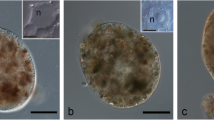Abstract
The distribution of polysaccharide depolymerase and glycoside (acid) hydrolase activity in nine genera of rumen entodiniomorphid and holotrich ciliate protozoa was examined by differential centrifugation. Sedimentable activity was detected in all of the protozoa examined and occurred principally in fractions that were prepared by centrifugation at 1000g for 10 min, 10,000g for 10 min, and 20,000g for 20 min (fractions F1, F2, and F3). Acid phosphatase was present in these subcellular fractions which contained membrane-bound vesicles 0.1–0.8 μm in size. The enzyme location profile of the subcellular fractions differed within the genera examined. The distribution of the enzyme activity in the subcellular fractions indicated the presence of distinct populations of hydrolase-containing organelles and other functional vesicles in the rumen ciliates.
Similar content being viewed by others
Literature Cited
Coleman GS (1983) The cellulase content of 15 species of entodiniomorphid protozoa, mixed bacteria and plant debris isolated from the ovine rumen. J Agric Sci Camb 104:349–360
Coleman GS, Hall FJ (1969) Electron microscopy of the rumen ciliateEntodinium caudatum with special reference to the engulfment of bacterial and other particulate matter. Tissue Cell 1:607–618
Coleman GS, Hall FJ (1974) The metabolism ofEpidinium ecaudatum caudatum andEntodinium caudatum as shown by autoradiography in the electron microscope. J Gen Microbiol 85:265–273
Coleman GS, Sandford DC (1979) The engulfment and digestion of mixed rumen bacteria and individual bacterial species by single and mixed species of rumen protozoa grown in vivo. J Agric Sci Camb 92:729–742
Coleman GS, Sandford DC, Beahon S (1980) The degradation of polygalacturonic acid by rumen ciliate protozoa. J Gen Microbiol 120:295–300
Delfosse J (1977) Ultrastructure de l'endoplasme des Ophryoscolescides. Cellule 72:77–90
Furness DN, Butler RD (1983) The cytology of sheep rumen ciliates. 1. Ultrastructure ofEpindinium ecaudatum Crawley. J Protozool 30:676–687
Furness DN, Butler RD (1987) The cytology of sheep rumen ciliates 2. Ultrastructure ofEudiplodinium maggii. J Protozool 32:205–214
Grain J (1966) Etude cytologique de quelques cilies holotrichs endocommensaux des ruminants et des equides. Protistologica 2:5–141
Hellings P, Debois M, Daubresse P, Thines-Sempoux D (1981) Subcellular distribution of hydrolytic activities in the rumen ciliates Ophryoscolecidae. Arch Int Physiol Biochim 89:B170-B172
Imai S, Katsuno M, Tsunoda K (1977) Scanning electron microscopy of rumen ciliates in cattle. Dobutsugaku Zasshi [Zool Mag] 86:194–207
Level M (1977) Carbohydrate determination with 4-hydroxybenzoic acid hydrazide (PAHBAH): effect of bismuth on the reaction. Anal Biochem 81:21–27
Lindmark DG, Muller M (1974) Biochemical cytology of Trichomonad flagellates: II. Subcellular distribution of oxidoreductases and hydrolases inMonocercomonas sp. J Protozool 21:374–378
Lloyd D, Poole RK (1979) Subcellular fractionation, isolation and characterization of organelles. Tech Metab Res B202:1–27
Lowry OH, Rosebrough WJ, Farr AL, Randall RJ (1951) Protein measurement with the Folin-phenol reagent. J Biol Chem 193:265–275
Miller GL, Blum R, Glennon WE, Burton AL (1960) Measurement of carboxymethylcellulase activity. Anal Biochem 2:127–132
Muller M (1973) Biochemical cytology of Trichomonad flagellates: 1. Subcellular localization of hydrolases, dehydrogenases and catalase inTritrichomonas foetus. J Cell Biol 57:453–474
Muller M, Baudhuin P, De Duve C (1966) Lysosomes inTetrahymena pyriformis: 1. Some properties and lysosomal localization of acid hydrolases. J Cell Physiol 68:165–176
Orpin CG, Hall CJ (1983) Surface structures of the rumen holotrich protozoonIsotricha intestinalis with particular reference to the attachment zone. Curr Microbiol 8:321–325
Roth LE, Shigenaka Y (1964) The structure and formation of cilia and filaments in rumen protozoa. J Cell Biol 20:249–270
Stern MD, Hoover, WH, Summers RG, Rittenburg JH (1977) Ultrastructure of rumen entodiniomorphs by electron microscopy. J Dairy Sci 60:902–910
Stern MD, Hoover WH, Leonard JB (1977) Ultrastructure of rumen holotrichs by electron microscopy. J Dairy Sci 60:911–918
Thines-Sempoux D, Delfosse-Debusscher J, Lefebvre V, Absil JP, Hellings P (1980) Aspects of “bacteria-ciliates” symbiosis in the rumen: postulated role of the bacteria in the digestive system of the ciliate. In: Schwemmler W, Schenk HEA (eds) Endocytobiology: endosymbiosis and cell biology, a synthesis of recent research. Proceedings of the international colloquium on endosymbiosis and cell research. Berlin: Walter de Gruyter, pp 371–379
Williams AG (1979) Exocellular carbohydrase formation by rumen holotrich ciliates. J Protozool 26:665–672
Williams AG, Coleman GS (1985) Hemicellulose-degrading enzymes in rumen ciliate protozoa. Curr Microbiol 12:85–90
Williams AG, Ellis AB (1985) Subcellular distribution of glycoside hydrolase and polysaccharide depolymerase enzymes in the rumen entodiniomorphid ciliatePolyplastron multivesiculatum. Curr Microbiol 12:175–182
Williams AG, Strachan NH (1984) The distribution of polysaccharide-degrading enzymes in the bovine rumen digesta ecosystem. Curr Microbiol 10:215–220
Williams AG, Yarlett N (1982) An improved technique for the isolation of holotrich protozoa from rumen contents by differential filtration with defined aperture textiles. J Appl Bacteriol 52:267–270
Williams AG, Withers SE, Coleman GS (1984) Glycoside hydrolases of rumen bacteria and protozoa. Curr Microbiol 10:287–294
Yarlett N, Hann AC, Lloyd D, Williams AG (1981) Hydrogenosomes in the rumen protozoonDasytricha ruminantium Schuberg. Biochem J 200:365–372
Yarlett N, Hann AC, Lloyd D, Williams AG (1983) Hydrogenosomes in a mixed isolate ofIsotricha prostoma andIsotricha intestinalis from ovine rumen contents. Comp Biochem Physiol 74B:357–364
Yarlett N, Coleman GS, Williams AG, Lloyd D (1984) Hydrogenosomes in known species of rumen entodiniomorphid protozoa. FEMS Microbiol Lett 21:15–19
Yarlett N, Lloyd D, Williams AG (1985) Butyrate formation from glucose by the rumen protozoonDasytricha ruminantium. Biochem J 228:187–192
Author information
Authors and Affiliations
Rights and permissions
About this article
Cite this article
Williams, A.G., Ellis, A.B. & Coleman, G.S. Subcellular distribution of polysaccharide depolymerase and glycoside hydrolase enzymes in rumen ciliate protozoa. Current Microbiology 13, 139–147 (1986). https://doi.org/10.1007/BF01568509
Issue Date:
DOI: https://doi.org/10.1007/BF01568509




